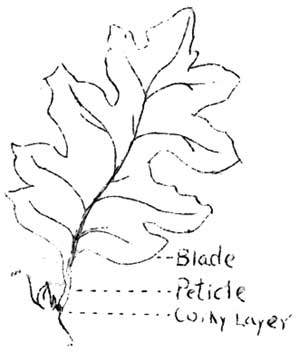

|
Come up to the Mesa at this time of the year and you will have the opportunity of observing Nature at her best. On reaching the "table-land" one can see all of the deciduous tress and shrubs bedecked in gorgeous crimsons, purples, browns and golds. The Oaks range through all the reds from scarlet to wine, and then add warm browns and bronze greens. The three-leaved sumac comes along with its brilliant scarlet and mottled yellow, while the service or Juneberry presents a gown of soft yellow and brown. Here and there the Juniper and Pinyon Pine thrust their tops of emerald green through the dense shrubbery, and the straw color of the grasses in the open flats complete the mantle. Swinging around the long graceful curves of the new highway a group of deer is encountered. Startled they bound down the hillside. Now a porcupine shuffles raspingly along the trail and again a rabbit bounces across the road ahead. Squirrels slip like brown and gray shadows, on the light carpet, laying in their winter stores. There seems to be no hurry about anything. The trees often take three or four weeks to strip their boughs for the winter. The leaves drift down silently, like great colored butterflies; whole troupes of them dancing in the gusts of wind. October is the time to study the fruits of the forest. The chrysalis of the butterflies and the cocoons of the moths can be more easily collected at this time. The galls caused by insect, mite or fungi are now exposed on the stem. Leaves may be discovered that have been folded together and held by silk for the protection of a variety of forms. Paper nests of hornets catch the eye, and the nests of birds, so cleverly hidden during the summer, can now be readily found. All these and others may be seen with ease in the autumn, if we will but set ourselves to the task. Why the Leaves Change Color in the Autumn. 
The remarkable displays of color are the result of life changes taking place in the plant. When the plant feels the approach of autumn, it not only puts on a thicker coat of bark over its twigs, but it begins to get ready to part with its leaves, at the least cost to itself. The first act is to withdraw to a place of safe keeping the precious chlorophyll and food material within the leaves. The chlorophyll which occurs in minute bodies within the leaf cells, is the green coloring matter and manufactures the food materials for the plant. This magic substance wears two coats, one green and one yellow. and all summer the green hides the yellow one. When the leaf stops making food the chlorophyll disintegrates in the light and is not replaced, in consequence the yellow coat is now visible. Also, while the chlorophyll is manufacturing food for the plant, it incidentally builds up "glucoside" or sugar. Now most leaves consist of two parts; the petiole, or stalk attached to the stem, and the thin expanded portion called the blade. (Figure 1) When autumn comes the tree grows a corky layer between the petiole and the twig. This cork door shuts off the glucoside and other substances within the leaf, where they oxidize. It is this glucoside which makes the rich red and scarlet in the leaves. The more glucoside held in the leaf the more brilliant the color. Some leaves retain a substance called tannin, and this is usually responsible for the soft brown and bronze colorings. The formation of this cork, or "separation" layer, in time causes the leaves to fall. The thin walled cells at the base of the petiole become definitely separated from each other by chemical changes of the protoplasm within them. One layer of corky cells remains on the twig to protect it so that there will be no wound when the leaf falls. | ||||||
| <<< Previous | > Cover < | Next >>> |
vol1-1c.htm
14-Oct-2011